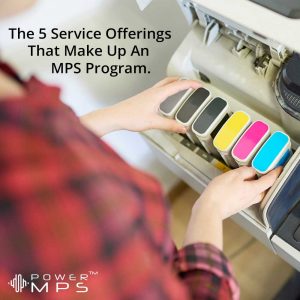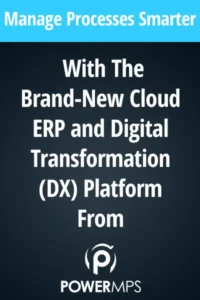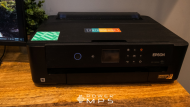Let’s take the mystery or any confusion out of the meaning of managed print services, also known as “MPS”. The reality is that managed print services can extend to many boundaries, limited only by the solution provider’s ability to deliver a complete solution specific to managing and supporting the print environment of a company.
What Is Managed Print Services?
Managed print services is made up of providing a complete yet customized solution to solving the needs of a specific customer’s printer and copier fleet. This can be a comprehensive set of hardware, software, services, supplies, and consumables, with support and infrastructure management that enables better printer and copier utilization and lower costs. However, by simplifying what MPS is or what an MPS program looks like as a value offering and solution from YOU (the provider), life will be easier on your organization’s effort in rolling out and delivering an MPS program, as well as being able to communicate and educate the end-user on what exactly MPS means for them.
MPS Is Flexibility, Transparency, And Automation For The Printer Fleet
 The most important aspect of MPS is the ability to monitor and manage the print environment with a print management software solution and data collection agent (printer dca). Delivering a managed print services solution requires at a minimum, an ALL-in-ONE software platform that will allow you to automate and streamline as much of your business processes as possible. Such as having the ability to track and report on devices and consumable data (i.e. page counts, print volumes & usage, track and monitor toner waste, track cartridge installation dates and cartridge utilization to prevent waste, track orders & shipments, etc.)
The most important aspect of MPS is the ability to monitor and manage the print environment with a print management software solution and data collection agent (printer dca). Delivering a managed print services solution requires at a minimum, an ALL-in-ONE software platform that will allow you to automate and streamline as much of your business processes as possible. Such as having the ability to track and report on devices and consumable data (i.e. page counts, print volumes & usage, track and monitor toner waste, track cartridge installation dates and cartridge utilization to prevent waste, track orders & shipments, etc.)
Keeping things simple, start small, and then GROW (depending on what your current offering and capabilities are today). First create YOUR own definition of what makes up YOUR MPS offering on a high level. For example, purposes, use the foundation of any MPS solution and know you must offer one or all of the following solutions, services, and/or toolsets to start:
• Data Collection Agent or printer dca Software (mandatory) – Print Device Monitoring
• Supply Fulfillment Program (Toner & Ink) – Automated supply fulfillment and order management processing
• Break-Fix Service & Maintenance – Printer service and repair program (JIT or SLA)
• Hardware Optimization – Print device sales, upgrades, etc.
• Toner Cartridge Recycling – Environmental sustainability program
Is the above an elementary breakdown of what encompasses Managed Print Services, of course it is. But that is my point. Keep it simple.
1. Define your purpose for offering MPS
2. Develop a Strategy to get there (start SMALL and then GROW)
3. Conduct a GAP analysis (including the type of solution you truly want to offer) and determine what capabilities you have today and what type of MPS solution you can currently offer (simple/basic or robust) and identify what the differences are.
4. Take an Inventory of your resources (that includes people, software, hardware, and capabilities), and determine what parts of an MPS Solution do you sell today and what skillsets do you currently have in-house to sell MPS.
5. Determine what else YOU need to close the GAP(s) and figure out how to get those things (utilize toolsets available on the marketplace that can streamline and automate processes, don’t try and re-invent the wheel, use relationships, partners, and other available resources, or acquire the things you need in order to reach the desired state of your MPS Solution Offering!
a. Determine the things you WANT to offer
b. Determine the things you CAN offer
c. Determine how to GET the things you CAN’T offer
The example of Providing the 5 service offerings as the core of what makes up an MPS program or MPS solution is key, (with the understanding that ALL of the above aspects of MPS do NOT have to be implemented at the same time in order to be considered an MPS program). Certainly, within each of the above service segments, there are a number of processes and procedures that take place which can and will turn the program from simple to robust, but that is the beauty of defining what your MPS offering consists of! Keep it simple. Start small and Grow. A most importantly, commit to learning and educating.
BASIC Components Of A Successful MPS Program
1- The MPS Educator/Director
First and foremost, there must be a committed MPS educator, director, or trainer at the dealer level, and there SHOULD be (in my opinion) a committed MPS educator, director, or trainer provided to the dealer at the distributor level. These point of contacts need to know all things MPS, including the vision, direction, toolsets, resources, with a goal of providing education top-to-bottom on the why and how managed print services is crucial and successful for all parties involved. Without these committed individuals, it’s going to be a challenge to garner MPS business from your clients.
2- The Printer DCA must be installed.
Without the deployment of the printer data collection agent (DCA) to monitor the end customers’ device fleet and print environment, there is zero visibility, transparency, or data to be able to offer the end customer with true MPS solution. Simply put, without an intelligent, flexible, brand-agnostic printer DCA, there is no start to offering an MPS program.
**NOTE – We will be outlining the detailed components for a successful MPS program in the coming weeks, so be sure to join our newsletter for details when it is live!
Detailing The Flexibility, Transparency, And Automation Of MPS
Flexibility in the general supply ordering and order fulfillment process:
• Providing automated toner and inkjet supplies fulfillment, which is only possible with the use of a printer DCA to monitor the device fleet and trigger consumable alerts and orders automatically at the right moment.
Flexibility in payment or billing options and structure:
• Providing the end-user with the ability for orders to be automated and purchased on a transactional basis. (The MPS DCA must be installed at the end-user location, an alert is triggered by MPS DCA, toner is shipped, end-user is charged or invoiced for the individual toner or ink consumable)
• Providing the end-user with the ability to be invoiced on a cost-per-page billing structure (DCA is monitoring print environment, page counters report is generated at the end of the billing cycle, end-user is invoiced for total pages printed during billing period x cost per page black & cost per page color) In addition to billing CPP, dealers also have the ability via the MPS DCA, to build in additional revenue-generating billing parameters, such as charging for scans, toner waste (utilization), page covered percentages, min/max page counts, additional flat fees, and more.
Transparency in what the print environment looks like:
• Dealer ability to monitor all print fleet-related data, including:
– device inventory
– page counts
– print volumes
– device make and models
– service and technical alerts
– cartridge utilization and consumable waste prevention
– fleet optimization and obsolescence avoidance
– actual page coverage
– consumables status and alerts
– preventative maintenance and downtime reporting
– consumable forecasting
– and more
• End-user visibility via a customer-facing data collection panel or dashboard to view
– the devices being monitored by the DCA
– fleet status
– page counters
– consumable alerts
– technical service events and alerts
– device uptime and downtime data
– TCO reporting
– and more
Automation for Print Fleet Management, Order Management
Including:
– Sales order & Purchase Order
– Supplies Fulfillment
– Technical Service & Support
– Device Analytics
– Billing
– Fleet Optimization
– and more
Providing transparent and flexible solutions to ordering consumables and automating the fulfillment process, along with monitoring the print fleet and environment so that both the end-user and dealer know EXACTLY what the print environment is costing (the end-user) and what opportunities reside within the environment to capture revenue (for the dealer), is the core value behind operating a true MPS solution. This is combined with the goal of securing and increasing the customer lifetime value (CLV).
The end-user and the dealer (MPS provider) all get value in the form of transparency and strategic control (with visibility and access to print devices being picked up by the DCA), long-term recurring revenue in the form of contractual agreements for providing the aforementioned MPS services defined, and closes the loop for keeping competitors out by offering more value-added services where the end customer does not need to go anywhere for services you can provide.







